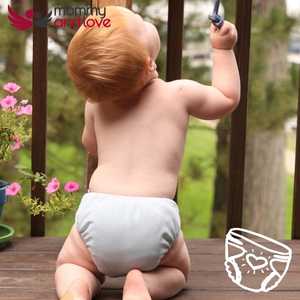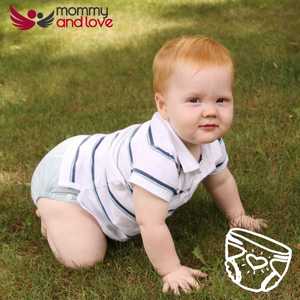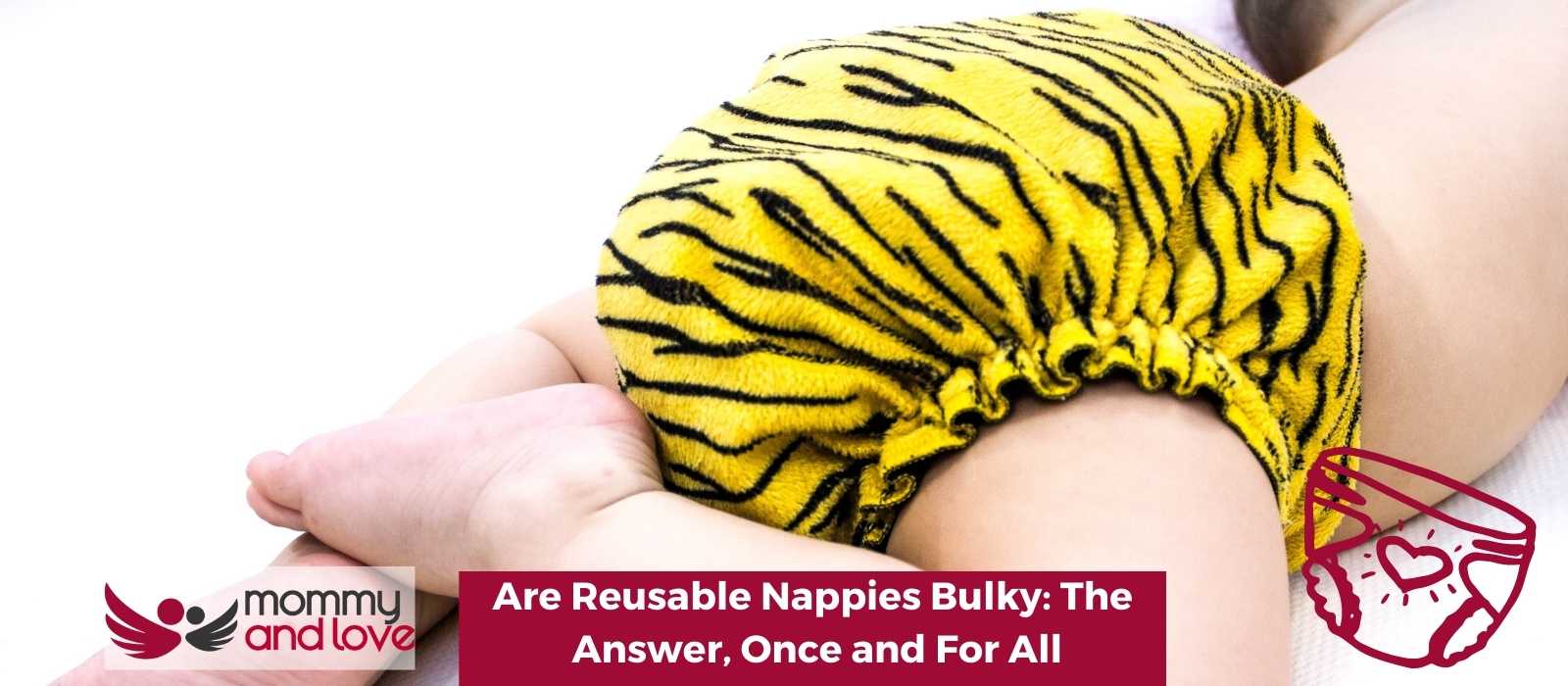Reusable nappies are bulkier than disposable nappies. Reusable nappies can be bulky, depending on the brand, the type of material, the type of nappy style, the sizing and how much absorbency your baby needs. However, the inverse is true and reusable nappies can be slim! Modern fabrics used in cloth nappies have really changed the design and what was once taken as a de facto fact, is now not the case.
What factors affect the bulkiness of nappies?
Sizing of Nappies
If you choose to go for one size birth to potty nappies from birth, then chances are they will be bulky looking on your newborn baby. If you buy super cute newborn nappies then they tend to be super slim and not bulky. Newborn nappies like the bumGenius littles or the Baba & Boo newborn pocket nappies are very slim fitting.
Types of cloth nappy
Modern cloth nappies come in a range of styles and some are naturally bulkier than others. If you go for a pocket nappy or an all in one nappy these are usually the slimmest of nappies. Combine these with super slim materials and you will have super trim nappies.
A Two-part system or fitted nappies, particularly those made from bulky materials like bamboo tend to be bulky, but also super absorbent.
All in two nappies tend to be on the slimmer side, but again it depends on the type of material used for the inner piece and how many pieces you need to add for your cild.
Though again these are just general guides. Some all in one nappies can be very bulky depending on the material used.
Material Absorbency
Generally speaking, the more a nappy can absorb the bulkier it will be. So nighttime nappies and nappies for super heavy wetters may be bulkier.
Certain types of material whilst more absorbent will be bulkier (and also usually take longer to try). The most common nappy materials are:
- Microfibre – Low absorbency/Slim fitting
- Bamboo – Medium absorbent/bulky fitting
- Organic cotton – Medium absorbency/medium fitting (depending don’t the type of cotton. Cotton jersey is slimmer for example than cotton terry.
- Hemp – Super Absorbent – medium fitting
The majority of nappies are designed to hold a certain amount of liquid, this is referred to as the ‘absorption rating’. The level at which you need your baby’s nappy will depend on their size, their age, how often you want to change them and the type of nappy that they are wearing.
Adjustability of Nappy
The majority if not all reusable nappies on the market can be adjusted in some way or another. The most common adjustment is a rise setting which will vary by brand but essentially means adjusting where it clips on your baby’s waistband. Many brands will offer multiple rise settings to suit your baby’s weight. A few different brands offer one size nappies with snap adjustability on the front.
Increasing Absorbency

Many modern nappies are also designed in a way that allows you to increase or decrease the amount of absorbency, which means you can make it work for the duration of time you need.
This is done by adding ‘boosters’ which are small inserts made from an absorbent material such as cotton and bamboo. The more boosters you add, the bulkier it will be.
Time of Day
You won’t need the same absorbency for a quick daytime change as you will for night nappies.
Often some people complain that their nappies are too bulky at night, and this may be the case. But also you can change your nappy system type or even brand or material to find a slimmer fitting night nappy that will work for you. Sometimes, however, you may just have a heavy wetting toddler which needs a super absorbent nighttime nappy and it will be bulky.
Your Child’s Requirements
The last thing which affects how bulky a cloth nappy might be is your child, their age and whether or not they are heavy wetters.
Most newborn babies tend to wee/poo little and often (especially if they are breastfed), so you can get away with super slim nappies here as they won’t need much absorbency.
As children get older their pooing tends to become more regulated and your nappies will need to stretch to 2-4 hours in the day and up to 12 hours overnight. Most babies will need changing every 3-4 hours so you can use cloth nappies which will last that long, you don’t always need to grab the big thick nappies.
If you have a heavy wetter you will need to add more absorbency which usually equates to more bulk.
How do you make cloth nappies less bulky?
You can make cloth nappies less bulky by changing the style of nappy you are using or changing the material you are using. For example, if you are using two-part nappies, you can move to a slim all in one nappy. Or you can change the material in the absorbent bit. Switch away from bamboo to an organic jersey or microfibre to make your nappies slimmer. Also, only use boosters if you have to.
If slimness is your priority switch to sized nappies over one size nappies as they will be trimmer fitting.
Will bulky nappies affect crawling and walking or healthy hip development?

I’ve raised three children in cloth nappies and my youngest two were both walking at 9 months so from my own personal experience absolutely not!
The myth that cloth nappies affect walking or babies hips has always made me smile, as most of our parent’s generations used cloth nappies (disposable nappies were not commonplace then!) and I see lots of our parents well able to walk!
They also used nappies in the times of big thick bulky terry squares, which are nothing like the modern equivalent.
The international hip dysplasia institute has clearly stated that bulky nappies do not cause hip problems. In fact, the opposite as they often recommend using bulky nappies on children who have hip dysplasia. They often recommend double diapering or using two disposable nappies to get the bulk! One cloth nappy will do a much better job at this and be a much lower environmental impact!
What are the Slimmest fitting cloth nappies?
Personally, I don’t mind a little bulky bum look on a baby, I love showing off their gorgeous prints which are so much prettier than disposables. But if slimness of nappy is a priority for you we recommend the following nappies:
- BumGenius Elemental – the slimmest nappy on the market with the best absorbency rating
- Charlie Banana pocket nappy
- Tots Bots Easy Fit
- Blueberry Simplex
- Motherease Wizard Uno One Size
Take Away
Basically, there’s no ‘one size fits all answer to the question of whether reusable nappies are bulky because it depends on each brand, style and design. The benefit of using cloth nappies far outweighs the minor disadvantage of being slightly bulkier than disposable nappies. So if buying disposable nappies or biodegradable disposable nappies for a slim fit, just remember there are other options!

This article was written by: Gian MIller – Full-Time Writer, Baby Whisperer & Dad of 3.
Gian spends a lot of his time writing. A self-proclaimed baby whisperer, Gian has been through it all with his own children and is passionate about sharing his hard-won wisdom with other parents. When he’s not writing or changing diapers, you can find him playing the guitar or watching baseball (or preferably both at the same time).




